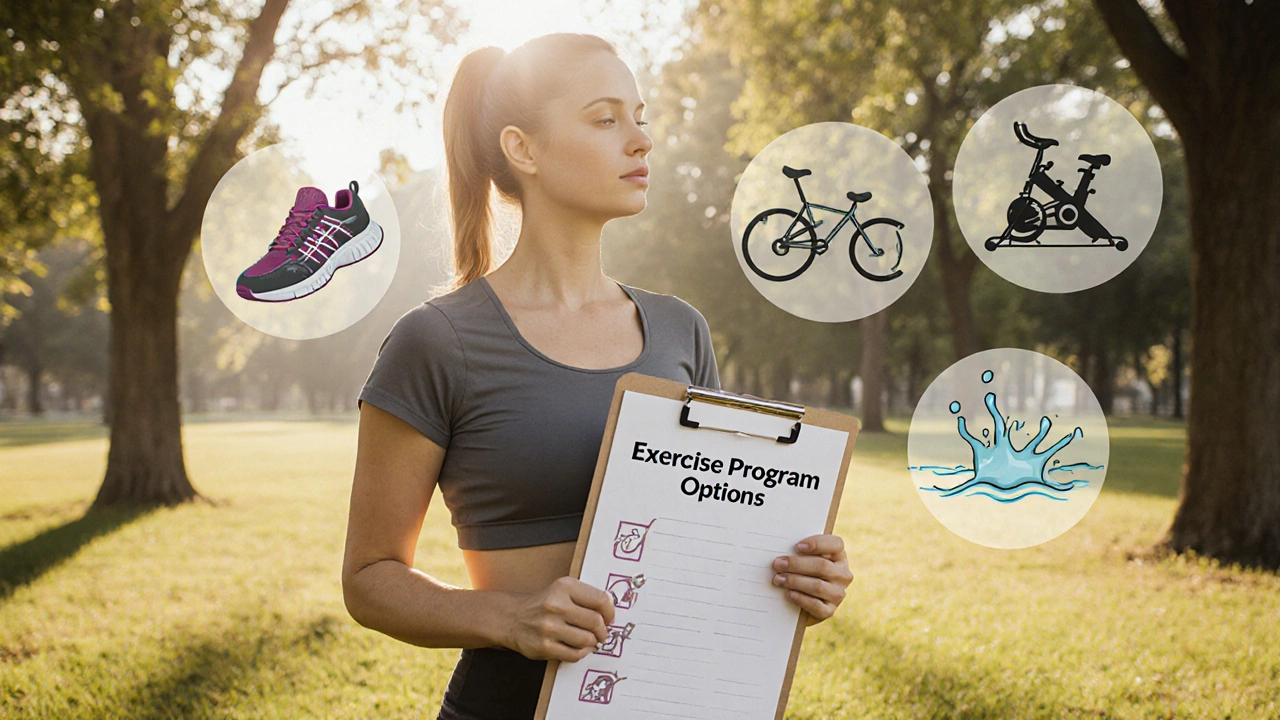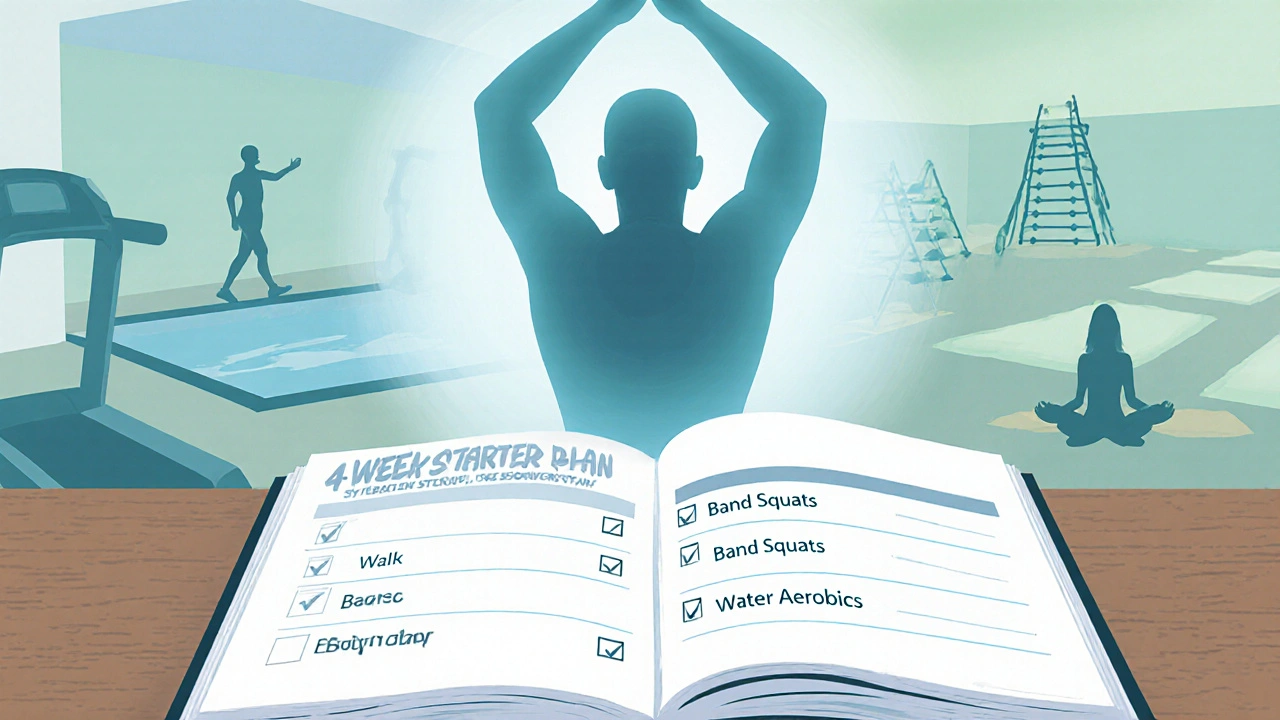
Joint Health Assessment Tool
Joint Health Assessment
Enter your information and click 'Get Recommendations' to see your personalized exercise plan.
Finding an exercise routine that protects your joints while still giving you a solid workout can feel like searching for a needle in a haystack. The good news? You don’t need to become a fitness guru to get it right. This guide walks you through the exact steps to pick a program that eases pressure on knees, hips, and shoulders, boosts mobility, and keeps inflammation in check.
What "Joint‑Friendly" Really Means
Joint‑friendly exercise program is a structured set of physical activities designed to strengthen muscles around the joints, improve range of motion, and minimize repetitive impact that can cause wear and tear. It usually blends low‑impact cardio, targeted strength work, and flexibility training. The goal is to support the joint capsule, cartilage, and surrounding ligaments without overloading them.
Assess Your Starting Point
- Identify any diagnosed conditions (e.g., osteoarthritis, rheumatoid arthritis, bursitis). Knowing the medical label helps you match the right intensity.
- Track pain levels on a 0‑10 scale during daily activities. Consistently high scores (7‑10) suggest you need a more conservative plan.
- Check mobility: Can you squat to a chair depth? Reach overhead without strain? Simple tests reveal weak spots you’ll want to target.
Jot these observations down; they become your baseline for measuring progress.
Core Components of a Joint‑Safe Program
A balanced routine covers three pillars:
- Low‑impact cardio activities that raise heart rate without repetitive pounding on joints. Think brisk walking, stationary cycling, or elliptical training.
- Strength training exercises that build muscle around the joint, providing natural shock absorption. Emphasize closed‑chain movements like leg presses, wall sits, and resistance‑band rows.
- Flexibility and mobility work stretches that keep connective tissue supple and improve joint range of motion. Gentle yoga or dynamic warm‑ups fit here.
When you combine these, you create a supportive environment for the cartilage and synovial fluid to function optimally.

Low‑Impact Cardio Options Compared
| Activity | Joint Stress (1‑5) | Calories Burned (30min) | Best For |
|---|---|---|---|
| Brisk Walking | 1 | 150‑200 | Beginners, knee‑sensitive users |
| Stationary Cycling | 2 | 210‑260 | Hip or ankle concerns, indoor workouts |
| Elliptical Trainer | 2 | 250‑300 | Full‑body low‑impact cardio |
| Water Aerobics | 1 | 200‑250 | Severe joint pain, weight‑bearing restriction |
| Rowing Machine | 3 | 260‑310 | Back and upper‑body conditioning |
Notice how water‑based work tops the list for minimal stress. If you have access to a pool, it’s a fantastic way to burn calories while letting your joints glide.
Strength Training That Shields Joints
Strength work isn’t just about bulking up; it’s about creating a muscular “cage” that cushions the joint. Here are three proven approaches:
- Resistance Band Circuits: Bands provide constant tension without the heavy load of free weights. Movements like band‑assisted squats, monster walks, and seated rows keep the load controlled.
- Machine‑Based Isolation: Leg presses, chest presses, and lat‑pull machines let you set a safe weight and move through a fixed range, reducing the risk of awkward form.
- Body‑Weight Progressions: Wall sits, modified planks, and supported lunges use your own weight, which can be adjusted easily by changing the angle or adding a chair for support.
Aim for two to three strength sessions per week, focusing on the major joint groups-knees, hips, shoulders, and spine. Keep reps in the 12‑15 range with moderate resistance to avoid overloading the joint capsule.
Flexibility & Mobility: The Unsung Heroes
Stiff muscles pull unevenly on joints, creating micro‑trauma over time. Incorporating daily mobility drills can cut that risk dramatically.
- Dynamic Stretching controlled movements that take joints through their full range while muscles stay active-leg swings, arm circles, and hip circles are perfect warm‑ups.
- Static Yoga Poses holds that lengthen connective tissue without bouncing, improving joint capsule elasticity-think Child’s Pose, Cat‑Cow, and Reclining Hand‑to‑Big‑Toe pose.
- Foam‑Rolling myofascial release technique that reduces muscle tightness around joints. Spend 30‑60 seconds on each major muscle group after workouts.
Even a 10‑minute flexibility routine after cardio can lower post‑exercise soreness by up to 30% (according to a 2023 study from the Arthritis Foundation).
How to Evaluate a Program Before You Commit
Not every “joint‑friendly” class lives up to the label. Use this checklist to vet options:
- Instructor Credentials: Look for certifications from the American College of Sports Medicine (ACSM) or similar bodies.
- Program Structure: Must include a warm‑up, main workout, and cool‑down. If any piece is missing, the routine may be incomplete.
- Impact Rating: Classes should advertise “low‑impact” or “joint‑safe.” Avoid anything that markets high‑intensity plyometrics unless you have a solid strength base.
- Progression Plan: A good program ramps intensity gradually (e.g., 5% increase in duration or resistance per week).
- Feedback Mechanism: In‑person trainers should ask about pain levels after each session; online programs should provide a way to log joints discomfort.

Sample 4‑Week Starter Plan
Below is a realistic schedule you can copy‑paste into a calendar. Adjust times based on your personal availability.
- Monday - Low‑Impact Cardio (30min): Brisk walk outdoors, focusing on a steady 3‑4mph pace.
- Tuesday - Strength (Full Body, 35min):
- Band squats - 3sets×12 reps
- Seated row (machine) - 3sets×12 reps
- Wall sit - 2sets×45sec
- Standing calf raise - 3sets×15 reps
- Wednesday - Mobility & Yoga (20min): Cat‑Cow, Child’s Pose, hip flexor stretch.
- Thursday - Rest or Light Activity: Gentle stretching or a short walk.
- Friday - Water Aerobics (30min) or elliptical if pool unavailable.
- Saturday - Strength (Upper Focus, 30min):
- Resistance band chest press - 3sets×12 reps
- Band pull‑apart - 3sets×15 reps
- Supported lunges - 2sets×10 each leg
- Sunday - Rest
Every week, add 2‑5 minutes to your cardio or increase band tension slightly. Re‑evaluate pain scores after week2; they should stay at or below a 3/10.
Red Flags - When to Pause or Seek Help
- Sharp, sudden pain that spikes during a movement-stop instantly.
- Swelling that doesn’t subside after 24hours-consult a physio.
- Persistent joint stiffness lasting more than 48hours post‑workout-reduce intensity.
- Signs of systemic inflammation (fever, night sweats) alongside joint pain-medical evaluation needed.
Listening to your body is the single most effective injury‑prevention tool.
Key Takeaways
- Define what makes an exercise program joint‑friendly: low impact, strength for support, and mobility work.
- Start with a clear self‑assessment of pain, mobility, and any diagnosed conditions.
- Combine cardio (walking, cycling, water aerobics), strength (bands, machines, body‑weight), and flexibility (dynamic stretches, yoga).
- Use a checklist to vet classes or online programs before signing up.
- Follow a progressive 4‑week starter plan and watch pain scores, not just calories burned.
Frequently Asked Questions
Can I do high‑impact sports if I have early‑stage osteoarthritis?
Usually not recommended as a start. High‑impact activities like running or basketball increase joint compression forces, which can accelerate cartilage wear. Begin with low‑impact alternatives, build strength, then re‑evaluate with your doctor.
How often should I stretch if my main goal is joint protection?
Aim for at least 10 minutes of dynamic stretching before workouts and 5‑10 minutes of static yoga poses afterward, five days a week. Consistency beats intensity for joint health.
Is resistance‑band training enough for someone with severe knee pain?
Yes, when performed correctly. Bands let you customize tension without loading the joint heavily. Pair band work with quadriceps‑activating exercises like wall sits to stabilize the knee.
Should I avoid swimming if I have shoulder arthritis?
Swimming is generally low‑impact for the shoulder joint, but freestyle can cause repetitive strain. Opt for backstroke or water‑aerobics that focus on gentle arm circles and avoid over‑stretching.
What’s the best way to track progress without a scale?
Record pain scores, range‑of‑motion measurements (e.g., how deep you can squat), and endurance (time you can hold a wall sit). Improvements in these metrics often precede weight changes.
7 Comments
ruth purizaca
October 21, 2025 at 05:50 AM
Honestly, this tool feels like a gimmick for the uninformed.
Shelley Beneteau
October 30, 2025 at 04:15 AM
Understanding your baseline pain level is crucial because it guides how harsh or gentle your first workouts should be.
For someone scoring a 3 or 4, low‑impact cardio combined with light resistance work is usually safe.
If the overhead reach test shows strain, incorporate scapular stability drills before raising arms overhead.
Always prioritize form over speed; a well‑executed movement protects the joint more than a rushed set.
Tracking progress weekly will let you see improvements and adjust intensity intelligently.
Sonya Postnikova
November 8, 2025 at 02:40 AM
Hey folks! 😊 I love that this tool pushes you to actually test your mobility before jumping into a program. It’s super helpful to see where you stand and then build up gradually. Just remember to keep the vibe light and celebrate small wins – every extra squat counts!
Anna Zawierucha
November 17, 2025 at 01:05 AM
Oh wow, because I’ve never heard of “low‑impact cardio” before – groundbreaking insight, really. Next you’ll tell us to “stay hydrated,” what a revelation. 🙄
Lolita Rosa
November 25, 2025 at 23:30 PM
Ah, the noble quest for joint salvation! We shall march, not with swords, but with gentle stretches, honoring the temple of our knees. Yet, remember, the battle is internal, so keep that spirit calm and the muscles supple.
Matthew Platts
December 4, 2025 at 21:55 PM
Totally feel you, Lolita. A steady pace and mindful movement will get the job done without any drama.






Lydia Conier
October 12, 2025 at 07:24 AM
When you’re trying to pick an exercise routine for joint health, the first thing to think about is how much stress you’re putting on those joints every day.
Low‑impact activities like swimming, water aerobics, or even a gentle bike ride let you get your heart pump without hammering the knees or hips.
If you have a bit of pain but can still move, start with short 10‑minute sessions and gradually add a couple of minutes each week.
Make sure you warm up with dynamic stretches, because cold muscles are more likely to irritate inflamed joints.
For people with osteoarthritis, strength training is a game changer; building the muscles around the joint gives it a natural brace.
Try body‑weight squats that don’t go deeper than a chair height, or use a resistance band for controlled leg presses.
Flexibility work like a seated hamstring stretch or a gentle yoga flow can improve range of motion without over‑stretching.
When you’re doing overhead reach tests, think about adding shoulder mobility drills such as wall slides before you lift those weights.
If you ever feel sharp pain, stop the exercise right away – it’s a sign that the joint may need more rest or a change in technique.
Keeping a log of your pain scores and what activities you did that day can help you spot patterns and adjust the plan.
Don’t forget to stay hydrated; water helps keep the cartilage flexible and can reduce stiffness.
A balanced diet rich in omega‑3 fatty acids, like salmon or walnuts, also supports joint lubrication.
If you’re unsure about any movement, a quick chat with a physical therapist can give you personalized cues.
Remember, consistency beats intensity – a modest routine done five times a week will beat a marathon session once a month.
So start simple, listen to your body, and keep tweaking the program as you learn how your joints respond.